Related Research Articles

A classical Kuiper belt object, also called a cubewano ( "QB1-o"), is a low-eccentricity Kuiper belt object (KBO) that orbits beyond Neptune and is not controlled by an orbital resonance with Neptune. Cubewanos have orbits with semi-major axes in the 40–50 AU range and, unlike Pluto, do not cross Neptune's orbit. That is, they have low-eccentricity and sometimes low-inclination orbits like the classical planets.
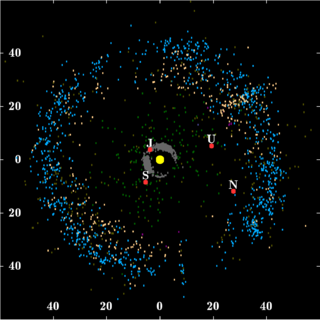
The Kuiper belt is a circumstellar disc in the outer Solar System, extending from the orbit of Neptune at 30 astronomical units (AU) to approximately 50 AU from the Sun. It is similar to the asteroid belt, but is far larger—20 times as wide and 20–200 times as massive. Like the asteroid belt, it consists mainly of small bodies or remnants from when the Solar System formed. While many asteroids are composed primarily of rock and metal, most Kuiper belt objects are composed largely of frozen volatiles, such as methane, ammonia, and water. The Kuiper belt is home to three objects identified as dwarf planets by the IAU: Pluto, Haumea, and Makemake. Some of the Solar System's moons, such as Neptune's Triton and Saturn's Phoebe, may have originated in the region.
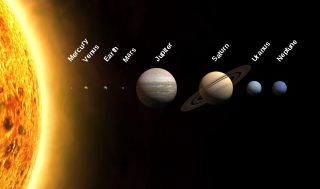
The Solar System is the gravitationally bound system of the Sun and the objects that orbit it, either directly or indirectly. Of the objects that orbit the Sun directly, the largest are the eight planets, with the remainder being smaller objects, the dwarf planets and small Solar System bodies. Of the objects that orbit the Sun indirectly—the natural satellites—two are larger than the smallest planet, Mercury, and one more almost equals it in size.

A trans-Neptunian object (TNO), also written transneptunian object, is any minor planet or dwarf planet in the Solar System that orbits the Sun at a greater average distance than Neptune, which has a semi-major axis of 30.1 astronomical units (AU).

In planetary astronomy, a centaur is a small Solar System body with either a perihelion or a semi-major axis between those of the outer planets. Centaurs generally have unstable orbits because they cross or have crossed the orbits of one or more of the giant planets; almost all their orbits have dynamic lifetimes of only a few million years, but there is one known centaur, 514107 Kaʻepaokaʻawela, which may be in a stable orbit. Centaurs typically exhibit the characteristics of both asteroids and comets. They are named after the mythological centaurs that were a mixture of horse and human. Observational bias toward large objects makes determination of the total centaur population difficult. Estimates for the number of centaurs in the Solar System more than 1 km in diameter range from as low as 44,000 to more than 10,000,000.

28978 Ixion, provisional designation 2001 KX76, is a large trans-Neptunian object and a possible dwarf planet. It is located in the Kuiper belt, a region of icy objects orbiting beyond Neptune in the outer Solar System. Ixion is classified as a plutino, a dynamical class of objects in a 2:3 orbital resonance with Neptune. It was discovered in May 2001 by astronomers of the Deep Ecliptic Survey at the Cerro Tololo Inter-American Observatory, and was announced in July 2001. The object is named after the Greek mythological figure Ixion, who was a king of the Lapiths.
Amy B. Jordan is an American astronomer and a discoverer of minor planets who works at the University of Colorado.
In astronomy, a resonant trans-Neptunian object is a trans-Neptunian object (TNO) in mean-motion orbital resonance with Neptune. The orbital periods of the resonant objects are in a simple integer relations with the period of Neptune, e.g. 1:2, 2:3, etc. Resonant TNOs can be either part of the main Kuiper belt population, or the more distant scattered disc population.

The scattered disc (or scattered disk) is a distant circumstellar disc in the Solar System that is sparsely populated by icy small solar system bodies, which are a subset of the broader family of trans-Neptunian objects. The scattered-disc objects (SDOs) have orbital eccentricities ranging as high as 0.8, inclinations as high as 40°, and perihelia greater than 30 astronomical units (4.5×109 km; 2.8×109 mi). These extreme orbits are thought to be the result of gravitational "scattering" by the gas giants, and the objects continue to be subject to perturbation by the planet Neptune.

2004 XR190, nicknamed Buffy, is a trans-Neptunian object, classified as both a scattered disc object and a detached object, located in the outermost region of the Solar System. It was first observed on 11 December 2004, by astronomers with the Canada–France Ecliptic Plane Survey at the Mauna Kea Observatories, Hawaii, United States. It is the largest known highly inclined (> 45°) object. With a perihelion of 51 AU, it belongs to a small and poorly understood group of very distant objects with moderate eccentricities.
(119070) 2001 KP77, provisional designation:2001 KP77, is a resonant trans-Neptunian object in the Kuiper belt, a circumstellar disc located in the outermost region of the Solar System. It was discovered on 23 May 2001, by American astronomer Marc Buie at the Cerro Tololo Observatory in Chile. The object is locked in a 4:7 orbital resonance with Neptune. It has a red surface color and measures approximately 176 kilometers (110 miles) in diameter. As of 2021, it has not been named.

(208996) 2003 AZ84 is a trans-Neptunian object with a possible moon from the outer regions of the Solar System. It is approximately 940 kilometers across its longest axis, as it has an elongated shape. It belongs to the plutinos – a group of minor planets named after its largest member Pluto – as it orbits in a 2:3 resonance with Neptune in the Kuiper belt. It is the third-largest known plutino, after Pluto and Orcus. It was discovered on 13 January 2003, by American astronomers Chad Trujillo and Michael Brown during the NEAT survey using the Samuel Oschin telescope at Palomar Observatory.

(15875) 1996 TP66, provisional designation 1996 TP66, is a resonant trans-Neptunian object of the plutino population, located in the outermost region of the Solar System, approximately 154 kilometers (96 miles) in diameter. It was discovered on 11 October 1996, by astronomers Jane Luu, David C. Jewitt and Chad Trujillo at the Mauna Kea Observatories, Hawaii, in the United States. The very reddish RR-type with a highly eccentric orbit has been near its perihelion around the time of its discovery. This minor planet was numbered in 2000 and has since not been named. It is probably not a dwarf planet candidate.
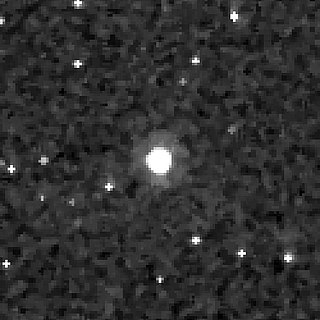
(119951) 2002 KX14, also written as 2002 KX14, is a medium sized trans-Neptunian object (TNO) residing within the Kuiper belt. It was discovered on 17 May 2002 by Michael E. Brown and Chad Trujillo.

42355 Typhon (; prov. designation: 2002 CR46), is a scattered disc object that was discovered on February 5, 2002, by the NEAT program. It measures 162±7 km in diameter, and is named after Typhon, a monster in Greek mythology.
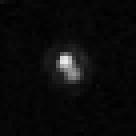
65489 Ceto, as a binary also (65489) Ceto/Phorcys, is a binary trans-Neptunian object (TNO) discovered on March 22, 2003 by Chad A. Trujillo and Michael Brown at Palomar. It is named after the sea goddess Ceto from Greek mythology. It came to perihelion in 1989.
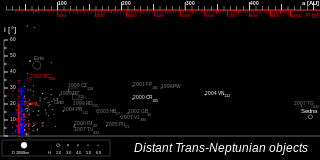
Detached objects are a dynamical class of minor planets in the outer reaches of the Solar System and belong to the broader family of trans-Neptunian objects (TNOs). These objects have orbits whose points of closest approach to the Sun (perihelion) are sufficiently distant from the gravitational influence of Neptune that they are only moderately affected by Neptune and the other known planets: This makes them appear to be "detached" from the rest of the Solar System, except for their attraction to the Sun.

2003 QX113 is a large trans-Neptunian object from the scattered disc located in the outermost region of the Solar System. It is one of the most distant objects from the Sun at 60.5 AU. It was discovered by astronomers with the Canada–France Ecliptic Plane Survey at Mauna Kea Observatories, Hawaii, when it was near aphelion on 31 August 2003. It was provisionally designated 2003 QX113.
2010 EU65 is a centaur, approximately 64 kilometers (40 miles) in diameter, orbiting the Sun in the outer Solar System. The object is also a promising Uranus horseshoe librator candidate. It was first observed on 13 March 2010, by American astronomers David Rabinowitz and Suzanne Tourtellotte, observing from Cerro Tololo and La Silla Observatory in Chile. As of 2021, it has neither been numbered nor named.
References
- ↑ "Minor Planet Discoverers (by number)". Minor Planet Center. 4 September 2016. Archived from the original on 29 May 2012. Retrieved 21 September 2016.
- ↑ Elliot, J. L.; Kern, S. D.; Clancy, K. B.; Gulbis, A. A. S.; Millis, R. L.; Buie, M. W.; et al. (February 2005). "The Deep Ecliptic Survey: A Search for Kuiper Belt Objects and Centaurs. II. Dynamical Classification, the Kuiper Belt Plane, and the Core Population". The Astronomical Journal. 129 (2): 1117–1162. Bibcode:2005AJ....129.1117E. doi: 10.1086/427395 .
- ↑ Buie, M. W.; Millis, R. L.; Wasserman, L. H.; Elliot, J. L.; Kern, S. D.; Clancy, K. B.; et al. (June 2003). "Procedures, Resources and Selected Results of the Deep Ecliptic Survey". Earth, Moon, and Planets. 92 (1): 113–124. arXiv: astro-ph/0309251 . Bibcode:2003EM&P...92..113B. doi:10.1023/B:MOON.0000031930.13823.be. S2CID 14820512.